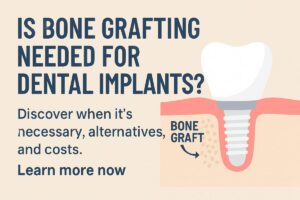The implant denture process replaces missing teeth by attaching a denture to implants placed in the jaw. This approach helps people who struggle with loose dentures, poor chewing, or bone loss. This post explains what implant dentures are, who’s a good candidate, the step-by-step treatment, and the benefits, risks, and next steps to help you decide if it’s right for you.
What the implant denture process is
Implant dentures are false teeth supported by dental implants instead of just sitting on the gums. There are two main types:
- Implant-supported (fixed): A full arch is attached to implants and is not removable by the patient. It feels most like natural teeth.
- Implant-retained (removable): The denture snaps onto implants (locators or bars) and can be removed for cleaning. It’s more stable than traditional dentures but still removable.
These differ from regular dentures, which rest on the gums and can slip or irritate tissues. They also differ from single implants, which replace one tooth. Implant dentures replace a full arch and use multiple implants to support many teeth at once.
Am I a good candidate for the implant denture process?
Most adults who want a more stable full-arch solution can be considered, but some health and lifestyle factors matter.
Medical and oral health factors
- Healthy gums or treatable gum disease — active infection should be treated first.
- Sufficient jawbone volume — some people need bone grafting if bone is low.
- Controlled chronic conditions — diabetes or autoimmune issues should be managed.
Lifestyle factors
- Smoking reduces healing and raises failure risk; quitting improves outcomes.
- Good oral hygiene and regular dental visits are important.
- Realistic expectations about time, cost, and maintenance.
Age alone is not a barrier. Overall health and bone support matter more than how old you are.
Step-by-step: the implant denture process
Consultation and treatment planning
Your dentist will review your medical history, take X-rays or a CBCT scan, and make impressions. You’ll discuss goals, options (fixed vs removable), timelines, and cost. A clear plan and written estimate help set expectations.
Implant placement surgery
During surgery, implants are placed into the jawbone under local anesthesia (with sedation options).u00a0Depending on your case, four to six implants per arch are common. Some patients get temporary teeth the same day (immediate loading); others wait until the implants heal (delayed loading). Surgery time and comfort vary but are usually manageable with local anesthesia and sedation if needed.
Healing and osseointegration
Osseointegration is when bone bonds to the implant. This usually takes 3 to 6 months. You may wear temporary dentures during healing. Normal healing includes mild swelling and soreness for a few days. Contact your dentist if you have severe pain, increasing swelling, fever, or pus — these can be signs of infection.
Attaching the denture and final adjustments
Once implants are stable, the final denture is attached. Options include fixed bridges bolted to implants, bar-retained dentures, or locator-retained removable dentures. Your dental team should explain each stage, answer questions, and provide written aftercare instructions. They’ll set follow-up visits to check healing and make adjustments as needed.
Benefits, risks, cost considerations, and next steps
Benefits
- Much better stability and chewing function than traditional dentures.
- Preserves jawbone and facial shape by stimulating bone.
- Improved speech, comfort, and confidence.
Risks and how they’re managed
- Infection or failed integration — managed with antibiotics, improved hygiene, or implant replacement.
- Need for bone grafting if bone is insufficient.
- Possible damage to nearby structures — planning with CBCT reduces this risk.
Cost considerations
Costs vary by number of implants, type of denture, bone grafting, and location. Many practices offer financing, phased treatment plans, or payment options to spread cost over time. Ask for a detailed estimate and what’s included.
Quick next steps
At your consult, bring a list of questions. Useful ones include:
- Am I a good candidate and why?
- How many implants will I need and what type of denture do you recommend?
- Do you use CBCT imaging and guided placement?
- What is the total cost and payment options?
- What is the expected timeline from surgery to final teeth?
Call your dentist to schedule an evaluation and start with imaging and a treatment plan if you’re interested. A clear plan helps you make an informed choice about the implant denture process.




